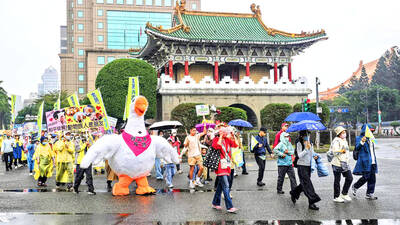The Atomic Energy Council yesterday held a nuclear safety review committee meeting at the Fourth Nuclear Power Plant in New Taipei City’s Gongliao District (貢寮), evaluating how Taiwan Power Co (Taipower) manages the mothballed facility, with protesters and residents criticizing the company’s safety measures and the plant’s environmental impact.
The plant was mothballed in July amid protests over the safety of nuclear power and Taipower has to maintain site safety during the storage phase.
There are 126 systems of the plant’s first reactor that need to be monitored during the time it is sealed, while 94 systems have been in uninterrupted operation, including cooling systems, air conditioning and electricity supply, plant general manager Wang Po-hui (王伯輝) said.
The remaining 32 systems are to be sealed in dry or wet-storage facilities while they are dormant, Wang said.
All of the 115 systems of the second reactor, which has not been completed after the government halted the construction in April, are sealed in nitrogen to keep out humidity, Wang said.
Committee member and Green Citizens’ Action Alliance chairperson Lai Wei-chieh (賴偉傑) said that Typhoon Soudelor had caused damage to some minor facilities, but committee members did not know of the problems until people living in the area reported them.
Showing photographs of open holes on walls of the second reactor complex and crude sealing of pipelines, Renli Borough (仁里) Warden Wu Sheng-fu (吳勝福) said that Taipower has been constantly modifying the facility, adding that such modifications might affect the complex’s structure.
Taipower said that it has made no modification that would affect the plant’s structural integrity.
New Power Party legislative candidate Huang Kuo-chang (黃國昌) asked whether Taipower has a contingency plan to manage the fuel rods stored in the plant.
A resident surnamed Yang (楊) said that every nuclear power plant is a high-level radioactive waste repository, which Taipower never made clear to locals.
Yang said Taipower and the council have put forward no meaningful evacuation plan so far in the event of a nuclear disaster, adding that transport and medical care would need to be provided.
Before the meeting, dozens of protesters, including Lai and Huang, rallied in front of the plant and called for an end to nuclear power, while demanding the deconstruction of the plant’s wharf.
The wharf has caused erosion at the nearby Fulong Beach (福隆), they said.
Yenliao Anti-Nuclear Self-Help Association director Wu Wen-chang (吳文樟) said that the beach has lost a large amount of sand since the completion of the wharf.
Lai said that fishing is prohibited in waters near the plant and the ban remains in place though the plant is shuttered indefinitely, damaging local residents’ interests and livelihood.
Democratic Progressive Party (DPP) Legislator Chen Ou-po (陳歐珀) proposed that the company’s used fuel rods be stored in the US, where they were manufactured, adding that the DPP would refuse any proposal to store nuclear waste on Taiwan’s outlying islands.

NUMBERS IMBALANCE: More than 4 million Taiwanese have visited China this year, while only about half a million Chinese have visited here Beijing has yet to respond to Taiwan’s requests for negotiation over matters related to the recovery of cross-strait tourism, the Tourism Administration said yesterday. Taiwan’s tourism authority issued the statement after Chinese-language daily the China Times reported yesterday that the government’s policy of banning group tours to China does not stop Taiwanese from visiting the country. As of October, more than 4.2 million had traveled to China this year, exceeding last year. Beijing estimated the number of Taiwanese tourists in China could reach 4.5 million this year. By contrast, only 500,000 Chinese tourists are expected in Taiwan, the report said. The report

Temperatures are forecast to drop steadily as a continental cold air mass moves across Taiwan, with some areas also likely to see heavy rainfall, the Central Weather Administration (CWA) said. From today through early tomorrow, a cold air mass would keep temperatures low across central and northern Taiwan, and the eastern half of Taiwan proper, with isolated brief showers forecast along Keelung’s north coast, Taipei and New Taipei City’s mountainous areas and eastern Taiwan, it said. Lows of 11°C to 15°C are forecast in central and northern Taiwan, Yilan County, and the outlying Kinmen and Lienchiang (Matsu) counties, and 14°C to 17°C

STEERING FAILURE: The first boat of its class is experiencing teething issues as it readies for acceptance by the navy, according to a recent story about rudder failure The Hai Kun (海鯤), the nation’s first locally built submarine, allegedly suffered a total failure of stern hydraulic systems during the second round of sea acceptance trials on June 26, and sailors were forced to manually operate the X-rudder to turn the submarine and return to port, news Web site Mirror Daily reported yesterday. The report said that tugboats following the Hai Kun assisted the submarine in avoiding collisions with other ships due to the X-rudder malfunctioning. At the time of the report, the submarine had completed its trials and was scheduled to begin diving and surfacing tests in shallow areas. The X-rudder,

DEMAND: The government should enact regulations in line with Austria and Germany to incorporate vegan nutrition into school meals, an advocate said More than 1,000 people yesterday marched in Taipei to promote veganism, calling for legislation to incorporate vegan diets into school lunches and the national net zero emissions program. Participants gathered on Ketagalan Boulevard in front of the Presidential Office Building for the march, which was organized by the Vegan Action Network (VAN). Former ambassador to Chad Chiu Chung-jen (邱仲仁), actor Yankee Yang (楊子儀) and actress Cindy Lien (連俞涵) attended the event. VAN member Marianne Chao (趙梅君) said that the campaign aimed to urge the government to promote vegan diets across schools and government agencies via legislation and national policies, which would help build